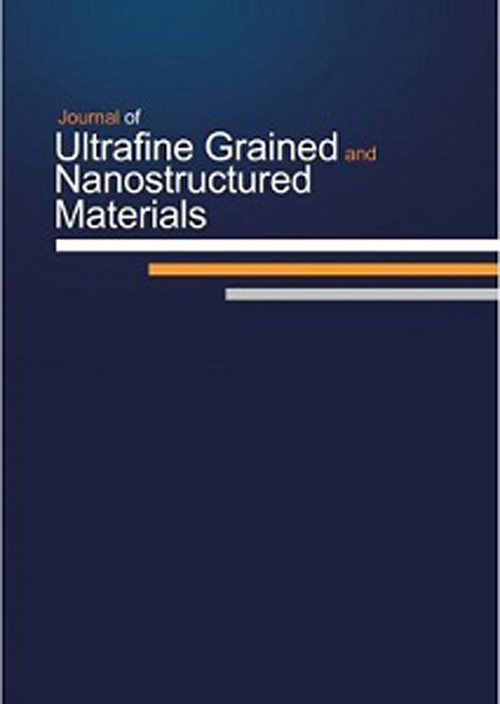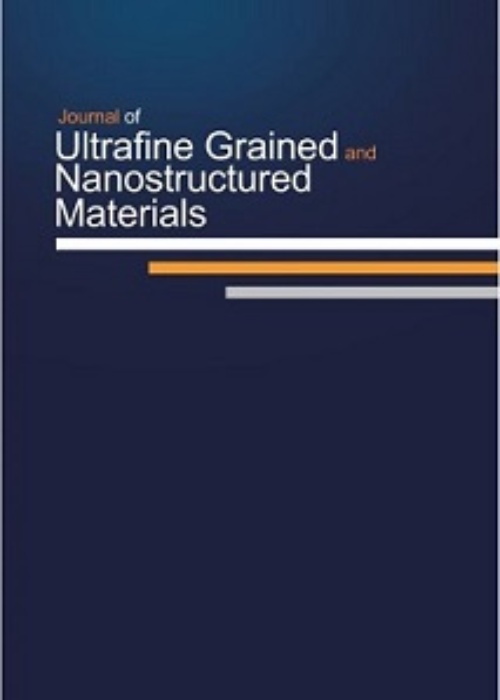فهرست مطالب

Journal of Ultrafine Grained and Nanostructured Materials
Volume:48 Issue: 2, Dec 2015
- تاریخ انتشار: 1394/09/30
- تعداد عناوین: 8
-
-
Pages 59-67In this research, the effect of different biopolymers such as polyethylene glycol (PEG) and polyvinyl alcohol (PVA) on synthesis and characterization of polymer/cobalt ferrite (CF) nano composites by mechanical alloying method has been systematically investigated. The structural, morphological and magnetic properties changes during mechanical milling were investigated by X-ray diffraction (XRD), Fourier transform infrared spectroscopy (FTIR), transmission electron microscopy (TEM), field emission scanning electron microscopy (FESEM), and vibrating sample magnetometer techniques (VSM), respectively. The polymeric cobalt ferrite nano-composites were obtained by employing a two-step procedure: the cobalt ferrite of 20 nm mean particle size was first synthesized by mechanical alloying route and then was embedded in PEG or PVA biopolymer matrix by milling process. The results revealed that PEG melted due to the local temperature raise during milling. Despite this phenomenon, cobalt ferrite nano-particles were entirely embedded in PEG matrix. It seems, PAV is an appropriate candidate for producing nano-composite samples due to its high melting point. In PVA/CF nano-composites, the mean crystallite size and milling induced strain decreased to 13 nm and 0.48, respectively. Moreover, milling process resulted in well distribution of CF in PVA matrix even though the mean particle size of cobalt ferrite has not been significantly affecetd. FTIR result confirmed the attachment of PVA to the surface of nano-particles. Magnetic properties evaluation showed that saturation magnetization and coercivity values decreased in nano-composite sample comparing the pure cobalt ferrite.Keywords: cobalt ferrite nano, particles, mechanical alloying, nano, composite, polyvinyl alcohol, polyethylene glycol
-
Pages 69-83A review on the microstructural evolution in magnesium alloys during severe plastic deformation was presented. The challenges deserved to achieve ultrafine/ nanostructured magnesium were discussed. The characteristics of the processed materials are influenced by three main factors, including i) difficult processing at low temperatures, ii) high temperature processing and the occurrence of dynamic recrystallization and grain growth processes, and iii) a combined effect of grain refinement and crystallographic texture changes. Reviewing the published results indicate that there are two potential difficulties with severe deformation of magnesium alloys. First, it is very hard to achieve homogeneous ultrafined microstructure with initial coarse grains. The second is the dependency of microstructure development on the initial grain size and on the imposed strain level. It was clarified that different grain refining mechanisms may be contributed along the course of multi pass severe deformation. It was clarified that discontinuous recrystallization takes places during the first stages of deformation, whereas continuous refinement of the recrystallized grain may be realized at consecutive passes. Shear band formation as well as twinning were demonstrated to play a significant role in grain refinement of magnesium alloy. Also, the higher the processing temperature employed the more homogeneous microstructure may be achieved with higher share of low angle grain boundaries.Keywords: magnesium, nano, ultrafine grain, recrystallization, SPD
-
Pages 85-91In this study, a novel method called atmospheric pressure solution evaporation (APSE) was developed for growing of Zinc Oxide (ZnO) nanostructures on Al2O3 surface. Zinc acetate dihydrate, Polyvinyl Pyrrolidone, and deionized water were used as precursor, capping, and solvent, respectively. The growth of ZnO nanostructures from evaporated solution was performed at three temperatures of 300, 400, and 500°C. Field emission scanning electron microscopy (FESEM) demonstrated that ZnO nanostructures formed in nanorods or cauliflower-like rods based on the growth temperature. X-ray diffraction patterns of ZnO nanostructures prepared at different growth temperatures were indexed as hexagonal Wurtzite structure without any impurity. The optical band gap energy evaluated by diffuse reflectance spectroscopy (DRS) was 3.22∼3.29 eV. Optical properties of the ZnO nanostructures are investigated by UVVis spectroscopy. There is a blue shift in the band edge with changing of the growth temperature. The degradation of Methylene Blue (MB) dye demonstrated that ZnO nanorods grown at the growth temperature of 300°C showed better photodegradation compared to other nanostructures. Antifungal properties of ZnO nanorods against Candida albicans were much higher than that of the other nanostructures. This method, compared to other synthesis methods of ZnO nanostructures, offers several advantages, such as simplicity, cost-effectiveness, low temperature, atmospheric pressure, and large area deposition. Such a low-temperature growth method may expose great opportunities for synthesis of ZnO nanorods onto various low-temperature endurance substrates and extend the field of ZnO-based nanoscale devices.Keywords: antifungal, atmospheric pressure solvent evaporation (APSE), growth temperature, photodegradation, ZnO nanostructures
-
Pages 93-99In this paper, two double helical dinuclear copper(II) complexes of bis-N,O-bidentate Schiff base ligands bis(3-methoxy-N-salicylidene-4,4'-diaminodiphenyl)sulfone (L1) and bis(5-bromo-N-salicylidene-4,4'-diaminodiphenyl)sulfone (L2) were prepared and characterized by elemental analyses (CHN), as well as thermal analysis. Elemental analyses (CHN) suggested that the reaction between ligands and copper salt has been occurred in 1:1 molar ratio. In these complexes the Schiff base ligands behaves as an anionic and bis-bidentate chelate and is coordinated to the copper(II) ion via two phenolic oxygen and two iminic nitrogen atoms. In these double helical dinuclear complexes, each copper(II) center has a pseudo-tetrahedral coordination sphere two-wrapped ligands. Thermal analysis of ligands and their complexes were studied in the range of room temperature to 750 °C with a heating rate of 10 °C min-1. TG plots show that the ligands and their complexes are thermally decomposed via 2 and 3 thermal steps, respectively. In addition, the complexes thermally decomposed in air at 520 °C for 3 h. The obtained solids characterized by Fourier transform infrared spectroscopy (FT-IR), X-ray powder diffraction (XRD) and transmission electron microscopy (TEM). The X-ray pattern result shows that the CuO nanoparticles are pure and single phase. The TEM result shows the as prepared CuO nanoparticles were very small and similar shape with particle size aboutKeywords: CuO nanoparticles, decomposed, double, helical dinuclear copper (II) complexes, pseudotetrahedral, thermal analysis
-
Pages 101-112Nano-encapsulated iron oxide in Zirconium oxide-coated mica pigments are thermally stable, innocuous to human health, non-combustible, and they do not conduct electricity. They could be applied in several industries such as thermoplastics, cosmetics, food packaging, children toys, paints, automobiles coating, security purposes, and banknotes. Nowadays, they are highly desirable in ceramic decoration. In the present study, intensively dark gold to bronze colored mica clay pigments, which were based on mica flakes covered with a layer of nano-iron oxide-Zirconium oxide particles, were prepared by homogeneous precipitation of iron nitrate and Zirconium chloride ammonia in the presence of mica flakes in two kinds of ore clay-based phlogopite and muscovite minerals. The final color was obtained by thermal annealing of precipitates at a temperature of 800◦C. The pigments were characterized by X-Ray Diffraction, Particle size analysis, Scanning electron microscopy, Transmission electron microscopy, X-Ray fluorescence, and Simultaneous thermal analysis. Results indicate that nano-encapsulated iron oxide in zirconia particles have been formed on mica flakes and kinds of clay-mica can be related to obtained shade from dark gold to bronze pearl. Higher particle size of mica flakes about phlogopite type of mica introduced pearl effects with higher L* changes in different angles. Muscovite performed higher hue and better pearl effect than phlogopite.Keywords: mica, muscovite, nano, encapsulation, pearl pigment, phlogopite, precipitation
-
Pages 113-124It has been revealed that the surface stress effect plays an important role in the mechanical behavior of structures (such as bending, buckling and vibration) when their dimensions are on the order of nanometer. In addition, recent advances in nanotechnology have proposed several applications for nanoscale shells in different fields. Hence, in the present article, within the framework of surface elasticity theory, the free vibration behavior of simply-supported cylindrical nanoshells with the consideration of the aforementioned effect is studied using an exact solution method. To this end, first, the governing equations of motion and boundary conditions are obtained by an energy based approach. The surface stress influence is incorporated into the formulation according to the Gurtin- Murdoch theory. The nanoshell is modeled according to the first-order shear deformation shell theory. After that, the free vibration problem is solved through an exact solution approach. To this end, the dimensionless form of governing equations is derived and then solved under the simply supported boundary conditions using a Navier-type solution method. Selected numerical results are presented about the effects of surface stress and surface material properties on the natural frequencies of nanoshells with different radii and lengths. The results show that the surface energies significantly affect the vibrational behavior of nanoshells with small magnitudes of thickness. Also, it is indicated that the natural frequency of the nanoshell is dependent of the surface material properties.Keywords: exact method, nanoshell, natural frequency, surface effect
-
Pages 125-132A nano/ultra-fine grain Al-0.2wt% Zr alloy was produced by accumulated roll bonding (ARB) process after 10 cycles. The fraction of high angle grain boundaries increased from 8% to 65.4% during 10 passes during ARB process. This alloy was subjected to tensile test at different temperatures (523,573 and 623 K) and strain rates (0.1 and 0.01 s-1). The optimum condition of temperature and strain rate of 623k and 0.01s-1 was achieved for maximum elongation to failure, leading to 100% elongation, although maximum elongation was achieved at higher strain rate and maximum chosen temperature. In fracture surfaces after the test, dimples in higher temperature were deeper, bigger, and longer than low temperature. Because of presenting the superplasticity character at elevated temperature and higher strain rate, there was no evidence of necking after failure.Keywords: elongations, strain rates, temperature, tensile test, ultra, fine grain
-
Pages 133-144Plasma electrolytic oxidation (PEO) was performed on a 1010 Aluminum alloy. To achieve the nanocomposite structure, Si3N4 nanoparticles were added into the electrolyte. In an alkaline aqueous suspension (silicate-based), the effect of adding NiSO4 on the applied voltage, microstructure, composition, wear, and corrosion resistance of PEO coatings was investigated using Scanning Electron Microscopy (SEM), elemental analysis with Energy Dispersive Spectroscopy (EDS), X-Ray Diffraction (XRD), cyclic polarization test, and pin-on-disk wear test. The results showed that adding nickel sulfate (NiSO4) and infiltration of its constituents into coatings lead to a more favored corrosion behavior. Moreover, in the case of best sample, anodic current at the highest applied potential condition during the cyclic polarization test indicated a drop within two decades. Moreover, coefficient of friction decreased almost by half.Keywords: aluminum, corrosion, electrolyte, nanocomposite, nickel sulfate, plasma electrolytic oxidation


